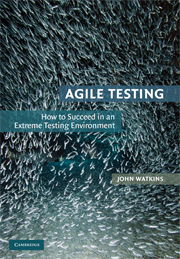Book contents
- Frontmatter
- Contents
- Foreword by Bob Bartlett
- Acknowledgments
- 1 Introduction
- PART 1 REVIEW OF OLD-SCHOOL AND AGILE APPROACHES
- PART 2 EVERYONE IS DIFFERENT: AGILE CASE STUDIES
- PART 3 AGILE MY WAY: A PROPOSAL FOR YOUR OWN AGILE TEST PROCESS
- APPENDIX A The Principles of Rapid Application Development
- APPENDIX B The Rules and Practices of Extreme Programming
- Appendix C The Principles of the Dynamic Systems Development Method
- Appendix D The Practices of Scrum
- APPENDIX E Agile Test Script Template
- Appendix F Agile Test Result Record Form Template
- Appendix G Agile Test Summary Report Template
- Appendix H My Agile Process Checklist
- References
- Index
PART 2 - EVERYONE IS DIFFERENT: AGILE CASE STUDIES
Published online by Cambridge University Press: 26 October 2009
- Frontmatter
- Contents
- Foreword by Bob Bartlett
- Acknowledgments
- 1 Introduction
- PART 1 REVIEW OF OLD-SCHOOL AND AGILE APPROACHES
- PART 2 EVERYONE IS DIFFERENT: AGILE CASE STUDIES
- PART 3 AGILE MY WAY: A PROPOSAL FOR YOUR OWN AGILE TEST PROCESS
- APPENDIX A The Principles of Rapid Application Development
- APPENDIX B The Rules and Practices of Extreme Programming
- Appendix C The Principles of the Dynamic Systems Development Method
- Appendix D The Practices of Scrum
- APPENDIX E Agile Test Script Template
- Appendix F Agile Test Result Record Form Template
- Appendix G Agile Test Summary Report Template
- Appendix H My Agile Process Checklist
- References
- Index
Summary
People think computers will keep them from making mistakes.
They're wrong, with computers you just make mistakes faster.
Adam OsborneThis section of the book contains twenty real-world case studies from organizations or individuals who have adopted and used existing agile methods or who have developed their own agile approaches to software testing.
Each case study follows a standard format and concludes with advice on what aspects of the approach worked well and what aspects might be improved or removed in future testing projects. The headings include
The case study title, author name(s), and a brief synopsis of the case study;
Introduction – introducing both the author and the case study;
Overview of the Testing Challenge – describing the particular testing challenges that needed to be addressed in this case study;
Definition of the Agile Testing Process – providing details of the particular agile testing solution employed in this case study;
Results of the Agile Approach – describing the outcome of the project and of the agile approach used in this case study; and
Lessons Learned – documenting the lessons learned during the project, including what agile practices worked well, what could be improved in future projects, and what practices should be treated with caution.
The following quick reference table provides a summary of the characteristics of each case study to make it as easy as possible for you to identify case studies that most closely match your own testing needs.
- Type
- Chapter
- Information
- Agile TestingHow to Succeed in an Extreme Testing Environment, pp. 29 - 30Publisher: Cambridge University PressPrint publication year: 2009



